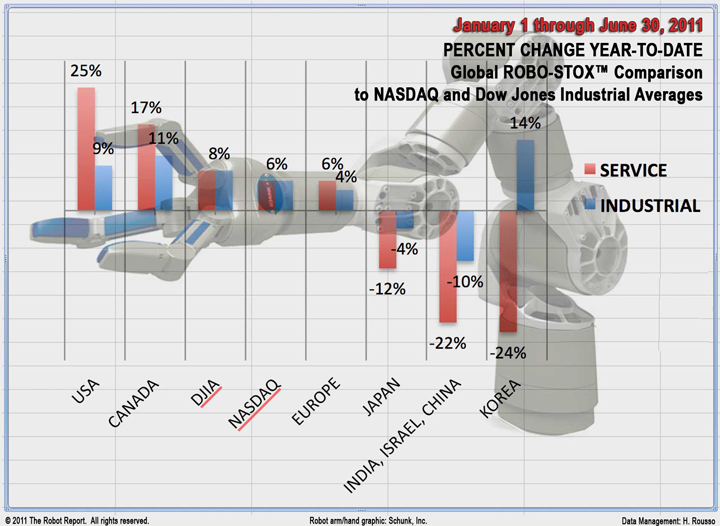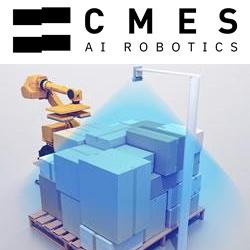In early 2008 I asked my Merrill Lynch broker for a list of stocks of American robot manufacturers. He couldn't provide me with more than two. So I went online with Bloomberg and found a list of 120 companies involved with automation. When I researched them, there were only a few in the U.S. and fewer still where robotics was the principle business.
Robot Industry Stock Information Lacking
Frank Tobe | The Robot Report
In a recent article appearing on a major NASDAQ website, it is clear that things haven't improved since 2008. The list is full of errors, omissions and was selected by market cap -- yet most of the companies are conglomerates with only a small portion of their sales from robotics, thus market cap is meaningless. As a consequence, not much of the information is of value even though the topic is relevant.
Their list of 10 robot stocks included ABB, Sony, Panasonic, Phillips, Raytheon, Aetna, Dover, Moog, Elbit and iRobot.
-
Only four of the ten are U.S. companies.
- iRobot derives 100% of its revenue from robotic products, mostly military (PackBots), but also consumer-related (Roomba vacuum cleaners).
- Raytheon, an aerospace/defense company, has many kinds of robotic products: drones, exoskeletons, vision systems, etc. Still, robotics represents only a very small portion of their overall revenue.
- Moog, another aerospace/defense contractor and systems integrator, derives some revenue from the manufacture of sensors, haptics, systems and ancillary products.
- Dover Corp, a machine manufacturer, gets just a small amount of their revenue from robots and robotic parts and components.
- Aetna, the American health care company listed, doesn't have any robotic activity whatsoever. The researcher confused Aetna with Aetna Group SpA, a privately-owned Italian robotics manufacturer. [I wrote to the analyst about this error and he replied that he is going to correct it asap.]
- ABB is a Swiss conglomerate; robotics represents only 18% of total revenue.
- Sony, a Japanese company, presently has no robotic products for sale, although it has many under development, the most prominent of which is Asimo.
- Panasonic, also Japanese, is a multi-product company with robotics representing a small percent of the total.
- Phillips, from the Netherlands, has few robotic products which represent only a minimal percentage of their revenue.
- Elbit, an Israeli defense contractor, is actively involved in unmanned aircraft, surveillance and other robotic systems - nevertheless robotics represent less than 20% of gross revenue.
- Missing from the list were the world's biggest robot manufacturers: KUKA and Reis (Germany), and Denso and FANUC (Japan).
Globally, there are slightly more than 250 publicly-traded robot and unmanned vehicle manufacturers. In the U.S. and Canada, the list is small but quite interesting. Here are 16 - in addition to the 4 shown above - to whet your appetite:
-
Healthcare:
- Intuitive Surgical and its da Vinci Robotic Surgical System are being installed at major hospital operating centers worldwide. Its stock is up over $100 so far this year!
- Mako Surgical has a robotic arm interactive orthopedic system for knee implants.
- Accuray's CyberKnife Robotic Radiosurgery System is an up-and-coming robotic radiation treatment methodology.
-
Defense/security:
- AeroVironment is a provider of unmanned aircraft, systems and services.
- Northrop Grumman, Rockwell Automation, General Dynamics, Boeing, Teledyne and Textron in the US and Macdonald Dettwiler in Canada are all involved in robotics to some extent - but only a portion of their revenue is derived therefrom.
-
General robotics:
- Adept Technology gets 100% of its revenue from robotics in manufacturing, food processing, automotive and warehousing applications.
- Many American publicly-traded engineering and consulting firms provide robot integration with value-added customization and services.
-
Ancillary businesses to the robotics industry:
- Trimble provides advanced positioning product solutions as does Hemisphere GPS in Canada.
- FARO Technologies provides 3D measurement and inspection arms and scanners.
- Cognex is a provider of machine vision products.
Since my experiences in 2008, and because of a personal belief that the robotics industry is the place to invest for the future, I have carefully compiled a proprietary list of global publicly-traded stocks reflecting all aspects of the robotics industry.

I monitor and report upon these stocks monthly in a performance/comparison chart, the Global Robo-Stox™ Comparison to the NASDAQ Index, the latest version of which can be seen and reviewed on The Robot Report website.
The content & opinions in this article are the author’s and do not necessarily represent the views of RoboticsTomorrow
Featured Product

